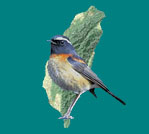 |
|
||||||||||||
|
|
|||||||||||||
 |
|
||||||||||||
|
|
|||||||||||||
|
Endemic Species White-whiskered Laughingthrush
Yellow Tit
Endemic Sub-Species
White-browed Shortwing
More Birds in Taiwan |
Pygmy Wren-Babbler Pnoepyga pusilla formosana Endemic subspecies
The Pygmy Wren-Babbler is an unmistakable, tiny, 9 cm (3 ½ inch) bird with almost no visible tail. The upperparts are dark olive-brown with a round spot of deep yellow on the feather tips, except the flight feathers. The underparts show a conspicuous scaly pattern of white edges on black feathers on the chin, throat, breast and belly, gradually changing to rufous and buff edges on dark brown feathers in the lower belly and vent area. The vocalization is described as a jumble of high, thin sibilant notes, usually beginning with a single note, then double notes, as: ‘seeee, see-see, see-see, see-see.’ The note is a wheezy ‘pshhhh’, similar to the sound of a bicycle when braking. This species is widespread and common, on or near the ground, in dense, damp forest of mid-elevation, between 1,000 and 2,000 m. Though shy and secretive, they are not particularly wary. When encountered in the shadows of undergrowth, they rarely flee but usually go about their business of foraging, ignoring the observer. The Pygmy Wren-Babbler in Taiwan, variously called Formosan Wren-Babbler, Taiwan Wren-Babbler, and Scaly-breasted Wren Babbler P. albiventer formosana, is vocally different from all other subspecies. Some authors consider “Taiwan Wren-Babbler” to be a separate species.
References: *Birds of the World: A Checklist, James Clements, with updates to July 2005
Field Guide: Birds of Taiwan; by Wang, J., C. Wu, G. Huang, X. Yang, Z. Cai, M. Cai and Q. Xiao. (1991)
Field Guide to the Birds of China, John MacKinnon & Karen Phillipps
Paul Holt, Sunbird/Wings, personal communication, October 2005
Scaly-breasted Wren Babbler, “Endemic subspecies of Taiwan birds—first impressions”, by N. J. Collar, in Birding ASIA, Number 2, December 2004
www.bsc-eoc.org/servlet/org.bsc.links.GoToLink?id=27265
Wayne Hsu, http://www.geocities.com/RainForest/9003/species.htm#near_endemics
|